A Broadwell Retrospective Review in 2020: Is eDRAM Still Worth It?
by Dr. Ian Cutress on November 2, 2020 11:00 AM ESTGaming Tests: Strange Brigade
Strange Brigade is based in 1903’s Egypt, and follows a story which is very similar to that of the Mummy film franchise. This particular third-person shooter is developed by Rebellion Developments which is more widely known for games such as the Sniper Elite and Alien vs Predator series. The game follows the hunt for Seteki the Witch Queen, who has arose once again and the only ‘troop’ who can ultimately stop her. Gameplay is cooperative centric with a wide variety of different levels and many puzzles which need solving by the British colonial Secret Service agents sent to put an end to her reign of barbaric and brutality.
The game supports both the DirectX 12 and Vulkan APIs and houses its own built-in benchmark as an on-rails experience through the game. For quality, the game offers various options up for customization including textures, anti-aliasing, reflections, draw distance and even allows users to enable or disable motion blur, ambient occlusion and tessellation among others. Strange Brigade supports Vulkan and DX12, and so we test on both.
- 720p Low, 1440p Low, 4K Low, 1080p Ultra
The automation for Strange Brigade is one of the easiest in our suite – the settings and quality can be changed by pre-prepared .ini files, and the benchmark is called via the command line. The output includes all the frame time data.

| AnandTech | Low Res Low Qual |
Medium Res Low Qual |
High Res Low Qual |
Medium Res Max Qual |
| Average FPS |  |
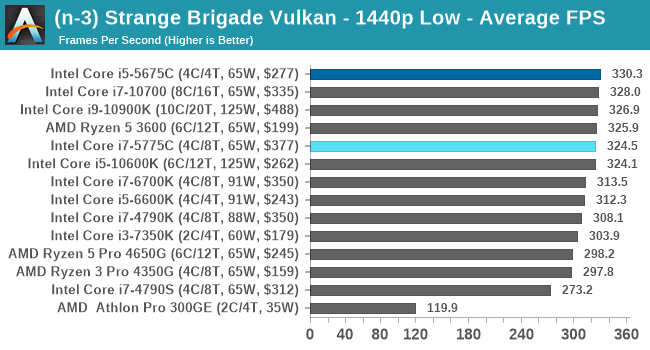 |
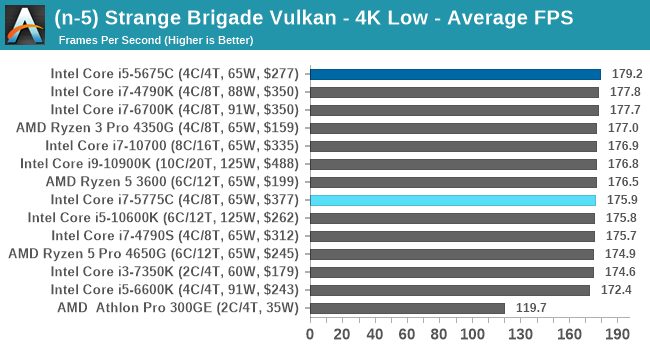 |
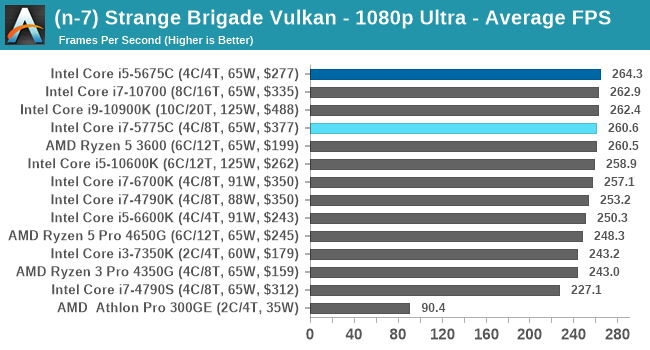 |
| 95th Percentile | 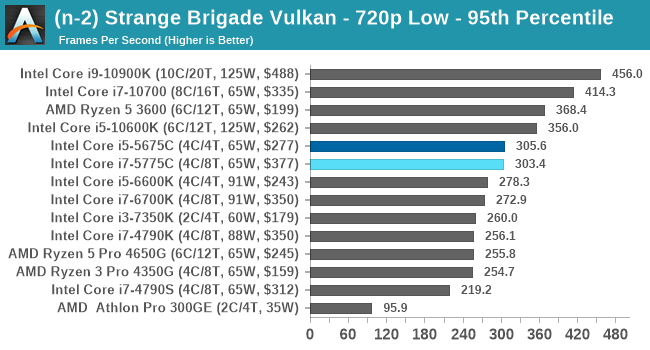 |
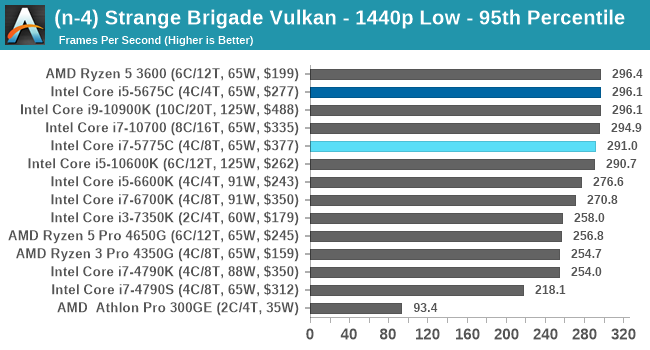 |
 |
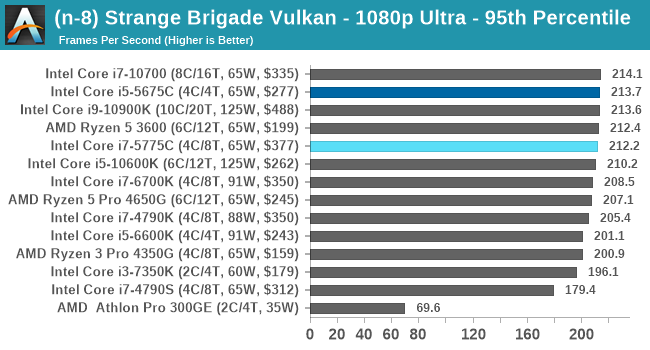 |
All of our benchmark results can also be found in our benchmark engine, Bench.


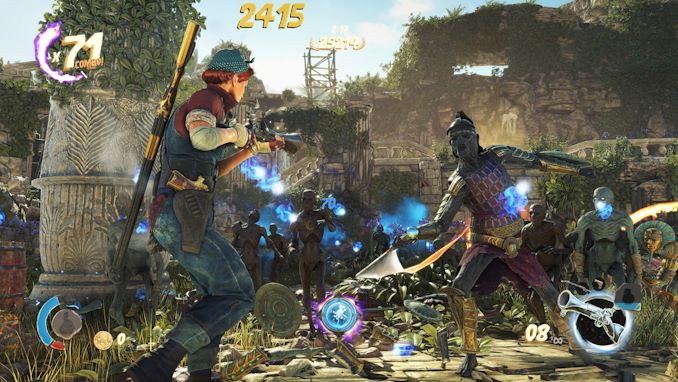








120 Comments
View All Comments
krowes - Monday, November 2, 2020 - link
CL22 memory for the Ryzen setup? Makes absolutely no sense.Ian Cutress - Tuesday, November 3, 2020 - link
That's JEDEC standard.Khenglish - Monday, November 2, 2020 - link
Was anyone else bothered by the fact that Intel's highest performing single thread CPU is the 1185G7, which is only accessible in 28W tiny BGA laptops?Also the 128mb edram cache does seem to make on average a 10% improvement over the edramless 4790S at the same TDP. I would love to see edram on more cpus. It's so rare to need more than 8 cores. I'd rather have 8 cores with edram than 16+ cores and no edram.
ichaya - Monday, November 2, 2020 - link
There's definitely a cost trade-off involved, but with an I/O die since Zen 2, it seems like AMD could just spin up a different I/O die, and justify the cost easily by selling to HEDT/Workstation/DC.Notmyusualid - Wednesday, November 4, 2020 - link
Chalk me up as 'bothered'.zodiacfml - Monday, November 2, 2020 - link
Yeah but Intel is about squeezing the last dollar in its products for a couple of years now.Endymio - Monday, November 2, 2020 - link
CPU register-> 3 levels of cache -> eDRAM -> DRAM -> Optane -> SSD -> Hard Drive.The human brain gets by with 2 levels of storage. I really don't feel that computers should require 9. The entire approach needs rethinking.
Tomatotech - Tuesday, November 3, 2020 - link
You remember everything without writing down anything? You remarkable person.The rest of us rely on written materials, textbooks, reference libraries, wikipedia, and the internet to remember stuff. If you jot down all the levels of hierarchical storage available to the average degree-educated person, it's probably somewhere around 9 too depending on how you count it.
Not everything you need to find out is on the internet or in books either. Data storage and retrieval also includes things like having to ask your brother for Aunt Jenny's number so you can ring Aunt Jenny and ask her some detail about early family life, and of course Aunt Jenny will tell you to go and ring Uncle Jonny, but she doesn't have Jonny's number, wait a moment while she asks Max for it and so on.
eastcoast_pete - Tuesday, November 3, 2020 - link
You realize that the closer the cache is to actual processor speed, the more demanding the manufacturing gets and the more die area it eats. That's why there aren't any (consumer) CPUs with 1 or more MB of L1 Cache. Also, as Tomatotech wrote, we humans use mnemonic assists all the time, so the analogy short-term/long-term memory is incomplete. Writing and even drawing was invented to allow for longer-term storage and easier distribution of information. Lastly, at least IMO, it boils down to cost vs. benefit/performance as to how many levels of memory storage are best, and depends on the usage scenario.Oxford Guy - Monday, November 2, 2020 - link
Peter Bright of Ars in 2015:"Intel’s Skylake lineup is robbing us of the performance king we deserve. The one Skylake processor I want is the one that Intel isn't selling.
in games the performance was remarkable. The 65W 3.3-3.7GHz i7-5775C beat the 91W 4-4.2GHz Skylake i7-6700K. The Skylake processor has a higher clock speed, it has a higher power budget, and its improved core means that it executes more instructions per cycle, but that enormous L4 cache meant that the Broadwell could offset its disadvantages and then some. In CPU-bound games such as Project Cars and Civilization: Beyond Earth, the older chip managed to pull ahead of its newer successor.
in memory-intensive workloads, such as some games and scientific applications, the cache is better than 21 percent more clock speed and 40 percent more power. That's the kind of gain that doesn't come along very often in our dismal post-Moore's law world.
Those 5775C results tantalized us with the prospect of a comparable Skylake part. Pair that ginormous cache with Intel's latest-and-greatest core and raise the speed limit on the clock speed by giving it a 90-odd W power envelope, and one can't help but imagine that the result would be a fine processor for gaming and workstations alike. But imagine is all we can do because Intel isn't releasing such a chip. There won't be socketed, desktop-oriented eDRAM parts because, well, who knows why.
Intel could have had a Skylake processor that was exciting to gamers and anyone else with performance-critical workloads. For the right task, that extra memory can do the work of a 20 percent overclock, without running anything out of spec. It would have been the must-have part for enthusiasts everywhere. And I'm tremendously disappointed that the company isn't going to make it."
In addition to Bright's comments I remember Anandtech's article that showed the 5675C beating or equalling the 5775C in one or more gaming tests, apparently largely due to the throttling due to Intel's decision to hobble Broadwell with such a low TDP.